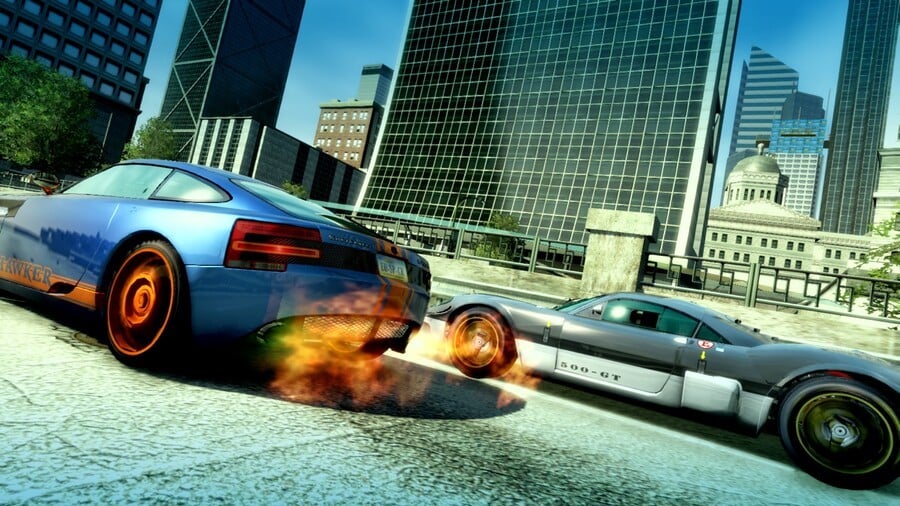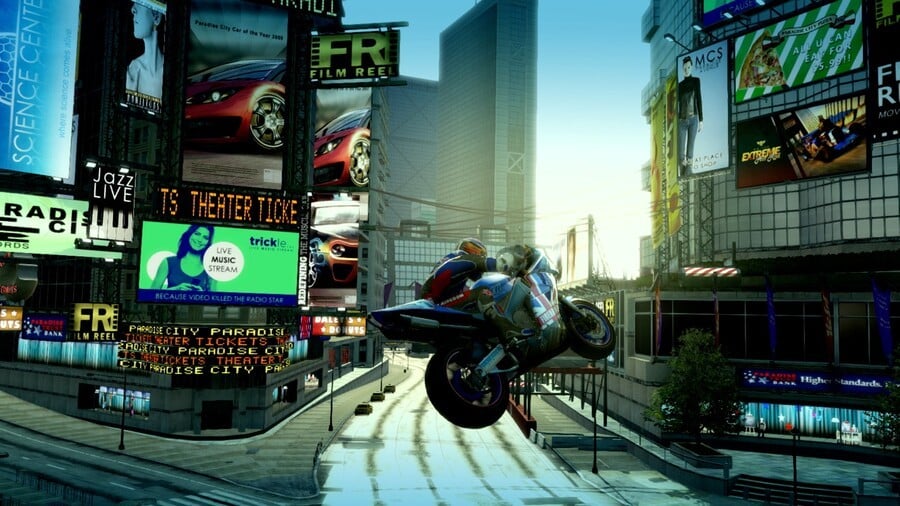
Over the holiday season we’ll be republishing a series of Nintendo Life articles, interviews and other features from the previous twelve months that we consider to be our Best of 2020. Hopefully, this will give you a chance to catch up on pieces you missed, or simply enjoy looking back on a year which did have some highlights — honest!
This feature was originally published in July 2020.
When word broke that 2008’s Burnout Paradise would be returning to consoles in remastered form, Switch owners got nervous when there was no mention of Criterion’s seminal open-world racer releasing on Nintendo’s platform. It took nearly two years, but a Switch port did eventually materialise and we’ve been enjoying it for the past month or so.
It’s been a while since a Burnout game came to a Nintendo platform and, frankly, we’d have been relatively content with a simple upscaled port in portable form. Fortunately, the dev team at Stellar Entertainment–the company responsible for Burnout Paradise Remastered–wanted to deliver something more worthy of a title which had a huge influence on the open-world racer genre.
“With the sheer amount of work it takes to properly resurrect the original game to run on modern systems both online and offline and integrate a years worth of additional content into the game, we felt the game deserved a comprehensive remaster,” Chris Roberts, Creative Director at Stellar tells us via email. “Also given the heritage of the game and franchise in question plus what we strive for as a studio we were just doing it justice.”
Stellar Entertainment is home to several ex-Criterion and Burnout series veterans, so the opportunity to work on the remaster was a rare chance for many of the team to ‘go home’ and revisit the series after a decade away.

“For all of us with a connection to the original series it was a very personal and rewarding experience, however, [as] lead designer on the first four Burnout games but [someone who] didn’t work on Paradise, it was a chance to ‘complete the set’.”
Striking a balance between preserving the much-loved game as fans remember it while also making improvements and additions is a tricky problem faced by any ambitious remaster project. ” The challenge with making this remaster was ensuring that we retained the spirit of the original whilst sympathetically updating it to feel right on modern platforms. A key challenge was retaining 60 FPS and improving the visuals across all platforms, including Switch […] if it’s not 60 FPS, it’s not Burnout.”
The starting point was to understand how the existing software ran on the Switch so that we had a clear idea of what we needed to do to get it running at 60 FPS
The two-year gap between releases on other platforms and Switch had us (and many others) confused for a while, and you’d be forgiven for thinking somebody in the publishing chain needed convincing to greenlight a Switch version, but according to Stellar that gap “was always the plan, we just waited until it lived up to our high standards and expectations […] We did some deep analysis of the software and hardware then made the most of all the available tools and support to help us do the right things.”
While the game obviously looks crisper on more powerful non-portable platforms, the Switch version maintains a rock-solid 60 fps throughout, an impressive feat considering how many other Switch ports end up reducing the target to 30. As Roberts tells us, hitting that target was a challenge which required not a small amount of ingenuity.
“The starting point was to understand how the existing software ran on the Switch so that we had a clear idea of what we needed to do to get it running at 60 FPS. We used Nintendo’s profiling tools to help us see where we would need to make adjustments for the Switch platform, support the choices we had to make and fully utilise the three available cores. One of the key decisions was to give audio it’s own core with a rewritten mixing library in ARM (the processor) Neon (the instruction library). We then packed the data for the correct memory alignments and sizes for Switch, meaning that when data streams in off the game cart or hard drive it’s decompressed as fast as possible and reading as many files as possible at any one time.

“For rendering we wanted to make sure we could achieve the same graphical fidelity as the other consoles and to achieve this we targeted 900p so that the post process effects had more bandwidth (as we’re rendering with less pixels). Dynamic resolution seamlessly handles the most intense scenes to help keep this all very smooth and in addition we have used the Nvidia version of ambient occlusion specially designed for the Switch. Handheld is limited to 720p, so is like an additional platform, so we optimised for that and utilised boost mode to tune the level of detail and balance it for handheld requirements. HD rumble runs in a parallel thread to give great contextual feedback and enhances the experiences. So as you can see from these few examples we made a lot of well informed decisions along the journey to help get us to our final destination!”
Although nothing is straightforward when you’re dealing with a ten year old code base, the Switch libraries were very helpful
The Switch version features touchscreen menu navigation and pinch-and-pull control for the map – very handy exclusive features that go the extra mile, although these sorts of additions are often missing in other ports. “We’re really pleased that we were able to implement the pinch and pull feature as it’s an important part of using the Switch and is a much better way of interacting with the map that only the Switch can provide.” We wonder how simple it was for the team to implement. “Although nothing is straightforward when you’re dealing with a ten year old code base, the Switch libraries were very helpful getting it up and running.”
As we mentioned above, for some of the team this was a relatively unique opportunity to revisit past work. Once they got into it, it must have been tempting to change or tweak other aspects beyond the original remaster remit, but Roberts and the team managed to resist. “Going into it we were super conscious that our job was to deliver a new way of playing Burnout Paradise, not to create a new game, so we were very focused and disciplined on doing that, and hopefully that shows.”
A decade in the game industry is a very long time from a technology perspective, and access to better, faster tools must be a big help these days. “That is certainly a part of it, plus you can make changes and see the changes in software much quicker.” Faster iteration makes for a better end product.

On the subject of iteration, Burnout Paradise’s open-world approach had a huge impact on the driving genre. We asked the team what it felt like to see the game’s influence on other titles in the years since. “I think we had an idea at the time that we were working on something truly groundbreaking,” Roberts remembers, “but it’s only after the fullness of time that you can appreciate the impact that it’s had, which is a great feeling.”
Obviously Burnout Paradise was a series highlight, but there are many fans who love other entries in the series even more, with Burnout 3: Takedown being a particular fan favourite. Before finishing up, we couldn’t resist asking about the chances of seeing further remasters or re-releases down the road.
“We certainly had a lot of fun making this, what would you like to see?”
Now there’s a question! You can let us know what you’d like to see in the comments below.
Our thanks to Chris and the team for their time. Burnout Paradise Remastered is out now on Switch.
